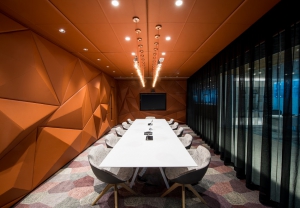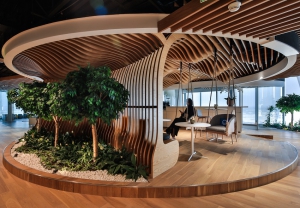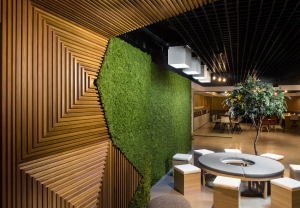Wood is universally beautiful to the man. It is the most humanly intimate of all materials.
Frank Lloyd Wright
UAE Architecture & Design from the Spectacular to the Sustainable
The UAE landscape sometimes seems like a stunning dreamlike utopian expanse, with some of the most breath-taking examples of modern architecture to be seen anywhere in the world. Both Abu Dhabi and Dubai boast amazing structures pushing the bounds of what is possible, including Yas Viceroy, Etihad Towers, Aldar HQ in the former, and the Louvre Abu Dhabi, Capital Gate and Burj Khalifa in the latter, among many other examples. [1] The rapid economic and social development of the Emirates since the 1960s has seen the traditional architecture of the old towns giving way to massive buildings reflecting the country’s growth in wealth, power and influence. For many decades the focus was on unfettered development, on the use of the most modern materials, on lavish expenditure, and on fabulous construction. But there is a transformation that occurs as the UAE is moving towards a new strategy, emphasizing sustainability and diversity. A recent article, reflecting on this change noted that Dubai’s architecture could be at a crossroad, where the focus of designs is now shifting from majestic and striking to green and approachable. [2]
The UAE has become a cultural and artistic hub, at the forefront of design breakthroughs and trends. A new style ethos is emerging in the Emirates, brought about by the collaboration of international and local designers. The perceptions and preferences of consumers, designers and architects are changing with an increasing awareness of the need to preserve the environment and to protect natural resources, alongside a shift in taste from the extravagantly grandiose to the luxuriously subtle. The government is also taking active measures to promote green building initiatives and investments. Proofs of this shift include the following:
Dubai ranks third among global cities with the highest number of green buildings; while the UAE is among the top 10 countries to hold LEED certification outside the US. [3]
- The International Renewable Energy Agency (IRENA) Headquarters located in Masdar City is the first office building to receive a Four Pearl ranking under Abu Dhabi’s Estidama standard. [4]
- Dubai Wharf’s Green Wall is the Middle East’s largest living green wall [5]
- Currently under construction, DEWA’s new Headquarters “Al Sheraa” (Arabic for sail), is expected not only to be the tallest government net zero energy building in the world, but also the largest, and smartest of its kind. [6] The building will be constructed according to the strict specifications of GEDSI, the Green Economy for Sustainable Development Initiative and it will strive to be awarded the highest LEED certification, Platinum.
One emerging trend is a refreshed reliance on wood in both construction and design. Wood has been notably absent in the UAE architecture until recently. But this is already beginning to change in a dramatic fashion as can be seen in the splendid design of the Dubai Opera house, which officially opened in 2016. The structure is inspired by the shape of the Dhow, the traditional sailing vessel evocative of the Dubai Creek. The 2,000 seat multi-use auditorium can be converted to a traditional theatre, concert or banquet hall or exhibition space using hydraulic technology. [7] The design weaves together traditional and modern features, including the extensive use of dark wood panelling in the ceiling. Wooden louvers are used in the lobby, which is enclosed in transparent glass, to shield from the sun without detracting from the sense of openness. [8]
Everything Old is New Again: Why Wood is the Most Modern Element in New Office Design
“Wood is a unique product of nature with a combination of practical, aesthetic and environmental benefits that set it apart from other construction materials”. [9]
Wood is one of the most ancient building materials used by humans, with archaeological evidence showing that it was used to make tools in the Palaeolithic period and to construct dwellings in the Neolithic period over 10,000 years ago.[10] The development of civilization is entangled with the many uses of wood. Humans have maximized its use – from tools, weapons, fuels, materials and many more. [11] Perhaps because it is so familiar, it’s just so easy to ignore how essential it is to us and to the society.
Wood is a beautiful, versatile and resilient material that can impart warmth, texture and colour to any setting, whether residential or commercial. It can create a sense of luxury or rustic simplicity. It is relatively lightweight and can be moulded into different shapes, and refashioned through carving, sanding, staining, painting, and so on. Many developers have now recognized its beauty and contribution to architecture. This can be demonstrated by the wood skyscrapers appearing all over the world especially in the US, Canada and various European cities [12]. Tokyo will also be the location of the world’s tallest wooden structure to be built by Japanese company Sumitomo Forestry. The 70-story tower will be constructed from 90% wooden materials and will cost $5.6 billion. [13]
Wood is Good for the Environment
The use of wood as a construction material sometimes evokes negative associations because of deforestation and the reduction of green areas. It seems counter intuitive, but in fact the use of sustainably sourced wood and wood products is a boon for the environment. Wood is the only construction material that is renewable. Sourcing wood through certification schemes ensures that the wood comes from sustainable forests. As trees grow, they absorb carbon dioxide from the atmosphere and store it long after the timber is harvested and used. The CO2 is not released back into the atmosphere unless the wood is burned. [14] So, using wood contributes to reducing the greenhouse gases.
Wood has a lower carbon footprint than other building materials such as steel and concrete. According to the Athena Model, wood is a greener choice than steel and concrete, based on its life cycle attributes. The model compares wood, steel and concrete throughout the life cycle of the material from the point of extraction to manufacturing, construction, building occupancy, building demolition, material disposal, reuse and recycling [15]. Wood overall is gentler on the environment than steel or concrete in energy use, carbon emissions, air and water pollution, and solid waste production.
The Engineered Wood Association has published research showing that the energy consumed to produce one ton of wood is significantly less than that for other materials. It takes 5 times more energy to produce 1 ton of cement; 14 times more energy to produce 1 ton of glass and 24 times more energy to produce 1 ton of steel. APA research has also demonstrated that while wood products constitute 47% of all US industrial raw materials, wood represents only 4% of energy used to produce these industrial raw materials. [16]
Wood is an Ideal Material for Office Fit Out
A recently completed research project studied the impact of the fit out – strip out cycle in large multi-tenanted office buildings. Wood based designs were compared with traditional fit out construction. Traditional fit out materials include aluminium, steel and glass. Some of the key findings include:
Traditional fit out consumes 16% more energy than wood-based design
Traditional office furniture consumes 47% more energy than wood-based furniture
- Wood-based internal walls reduce energy consumption by around 35%
- Traditional materials emit high volumes of greenhouse gases during the manufacturing process when compared with wood
- Traditional design internal walls using metal stud and plasterboard emit nearly 54% more greenhouse gases than wood-based partition panels. Also, traditional workstations and pedestals emit more than 70% more greenhouse gases than wood-based products.[17]
According to the WPA (Wood Protection Association), the benefits of using wood in construction and commercial fit out include:
- Lightweight material with abundant structural and decorative potential
- High strength to weight ratio – 16X lighter than steel; 5X lighter than concrete on strength for strength basis
- High thermal and sound insulation characteristics
- High reuse – recycling potential at the end of life
- Fire resistant properties:
- Mechanical properties and low-expansion coefficient lend it residual strength; meaning will not collapse or buckle in a fire as quickly as steel
- Wood produces charred outer layer than insulates un-burnt core; fire spreads more slowly [18]
The Healthy Office Needs Wood
In previous posts, we have discussed the importance of incorporating biophilic elements in office fit out. Wood materials should always be a fundamental component of any commercial fit out because of its beauty, flexibility and efficiency. Architects, designers and fit out contractors are also turning to wood because it is hypoallergenic, easy to clean, and improves indoor air quality and acoustics. [19]
There are an increasing number of studies linking the use of wood in interior design and fit out to improved psychological health, less stress and decreased blood pressure. [20]
- Psychological Responses: A Canadian psychological study assessing individuals’ reactions and perceptions of wood in interiors found that the subjects had a strong preference for rooms containing many wood details. There was a common belief that wood helps to create a healthier environment. Rooms containing wood details and features were mainly described as “warm,” “comfortable,” “relaxing,” “natural,” and “inviting.” [21] The benefits of fostering such attitudes among employees in an office go without saying.
- Physiological Responses:
- A Japanese study compared the effect of looking at wood compared to steel on the body. It was found that generally looking at wood panels reduced depression and blood pressure rates, while steel increased negative feelings as well as blood pressure [22].
- An Austrian study examined whether the use of interior wood in classrooms has any effects on students. It was found that students in wood classrooms experienced less stress, had lower heart rates and lower blood pressure than those in the control group (traditional classrooms). [23]
How to Successfully Integrate Wood into Office Fit Out
The use of wood as a structural, decorative or finishing material increases the aesthetic value of a space and sometimes even its market value. A National Wood Flooring Survey of realtors found that 90% of said houses with wood flooring sell faster and for higher prices than those without. [24] Wood contributes to creating a biophilic atmosphere, which improves employee morale, health, and productivity. Wood enhances indoor air quality, thermal comfort, acoustics and increases energy efficiency. The creative design possibilities offered by this material are seemingly endless. It can be adapted and styled to suit all tastes. It can be heavy, ornate, and formal, traditional or modern, light and airy.
Summertown Interiors has always been a trailblazer in sustainable fit outs, and design and build offices in the region.
For many years, Summertown has been using wood as a key element in its fit-out and retrofit projects, including panelling, trim, bookcases, countertops, and reception consoles. Many of Summertown’s projects provide excellent examples of the way wood can be used in a sustainable and green way that complements the vision of interior designers and architects, and that enhances the office working environment. Summertown has unequaled experience in woodworking. The company has its own custom joinery factory to ensure that all wood used is sustainably sourced and that paints and stains are of low VOC and non-toxic. All phases in the fit out including production, finishing and installation are carried out with an extreme eye for detail to ensure the highest quality. For example, Summertown used 100% certified wood for responsible forestry in fitting out its Headquarters. Other recent Summertown fit-out projects that demonstrate the creative use of wood and other green materials include:
Key Materials: White oak, natural rope, living plants
The office’s design is inspired by Dubai’s shifting sand dunes and creek so there was an emphasis on creating a sense of organic movement and flow throughout the space. Summertown installed a stunning intricate curved wooden ceiling made up of individually formed panels and wooden oak flooring. All the joinery items were custom-built. The space is also enhanced by living plants and natural rope partitions. [25]
Smart Dubai Government
Key Materials: White oak, living plants [26]
Summertown utilized natural materials, indoor gardens and quality crafted white oak panelling [27] in the office fit out to actualize the design of Bluehaus Group. The client wanted a space that was innovative and that incorporated the latest in high-tech working solutions while creating a hospitable and healthy environment for employees. The result was a design that can represent the best-case scenario in integrating biophilic design in the office. Emirati culture and the traditional landscape dominated by the ocean, sand dunes, and desert oases served as the inspiration for geometric motifs and decorative elements. Living plants, open plan meeting areas, and a CEO office featuring a tent-like ceiling along with a colour scheme, revolving around natural tones of brown, grey and blue, add up to a unique space that while contemporary and professional, also draws strength from nature and Emirati heritage. Wood is used extensively in the office including, wood flooring, wood furniture, a feature wall with intricate geometric wood panelling offsetting a moss wall, and wood panelled ceilings.
 Dubai Design District (d3) Headquarters
Dubai Design District (d3) Headquarters
Key Materials: Wood Veneer, Crown cut Oak Veneer & Leather
Summertown worked closely with project managers Tamdeen to enhance the fit out, design and featured wooden joinery. The headquarters is an understated but elegant contemporary bespoke interior featuring sloping shelving units, wooden flooring wood panelled ceilings and wood furniture. [28] The wood in different shapes, shades, and textures, perfectly complement the other core materials of the design including stone, marble and leather.
The common thread uniting these different projects is the use of sustainable office fit-out materials, including wood in interesting and innovative ways. All three projects focus on integrating aspects of the surrounding or natural environment and/or Emirati culture in the design. This is done while integrating high-tech working solutions, exemplifying the best aspects of culture in the UAE and, cherishing traditional values, while embracing the innovations and promise of the future. Each project delivers different answers to providing employees and visitors with productive, clean, comfortable spaces for work or rest.
If you decide to revamp your office fit out and transform it into a sustainable one by using wood and other biophilic elements, contact Summertown Interiors today and let us know your requirements.

